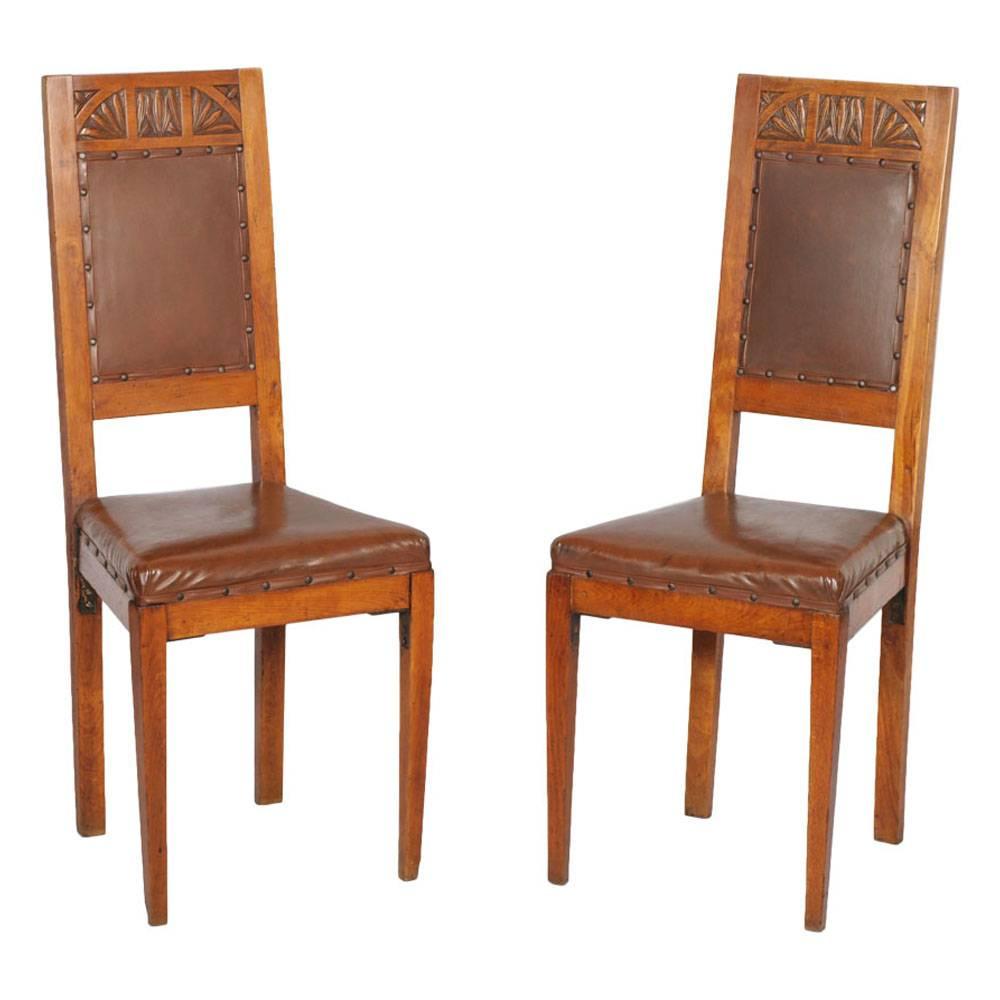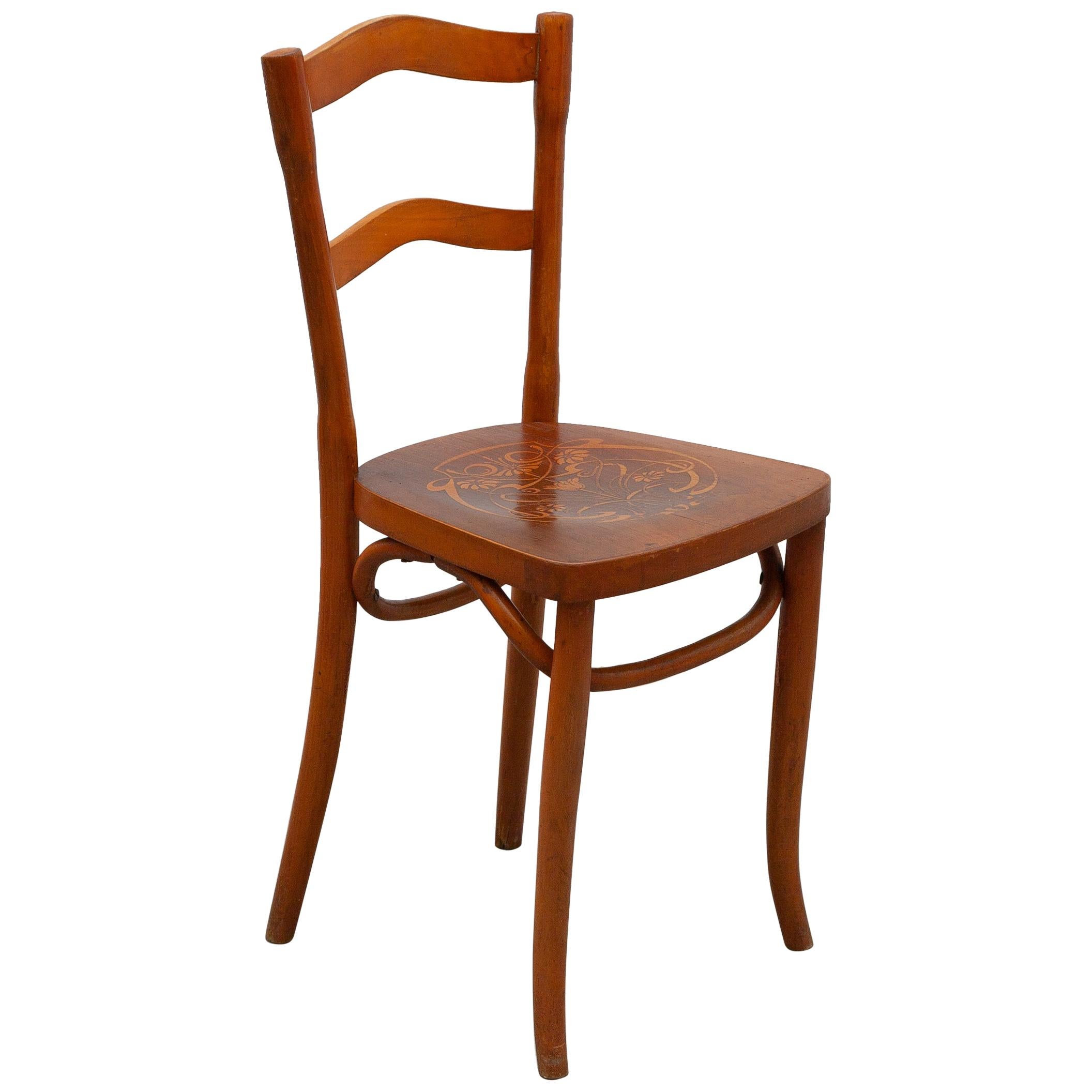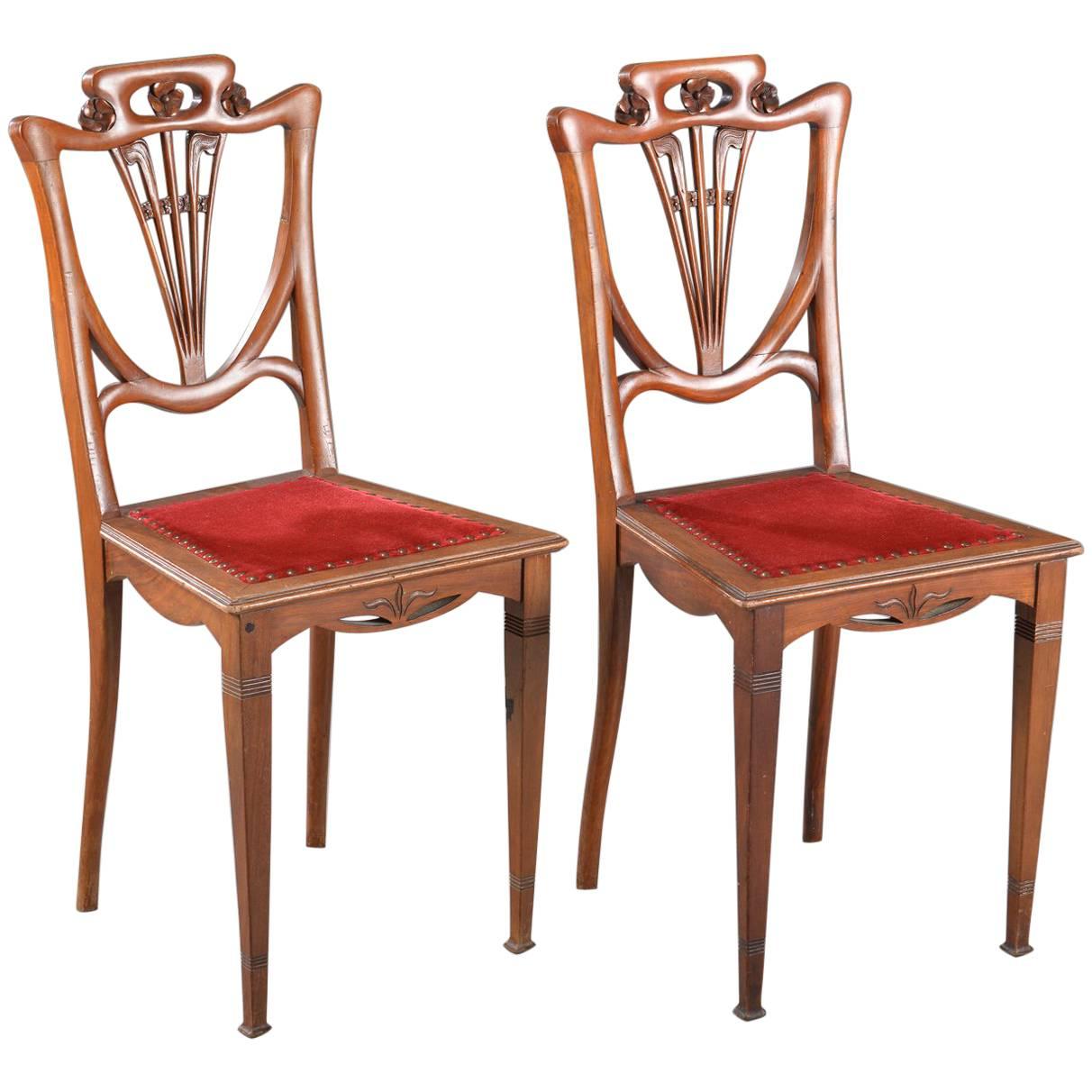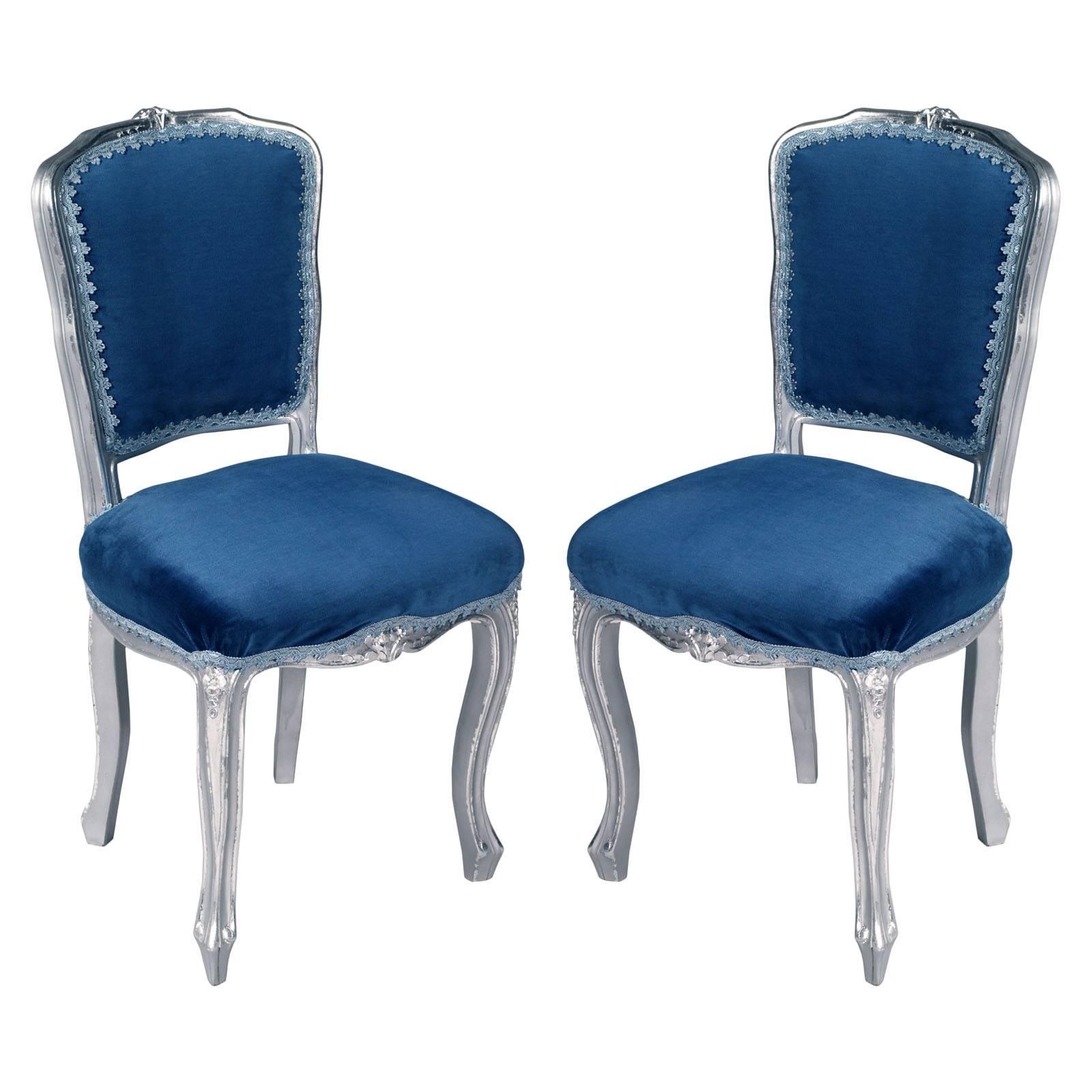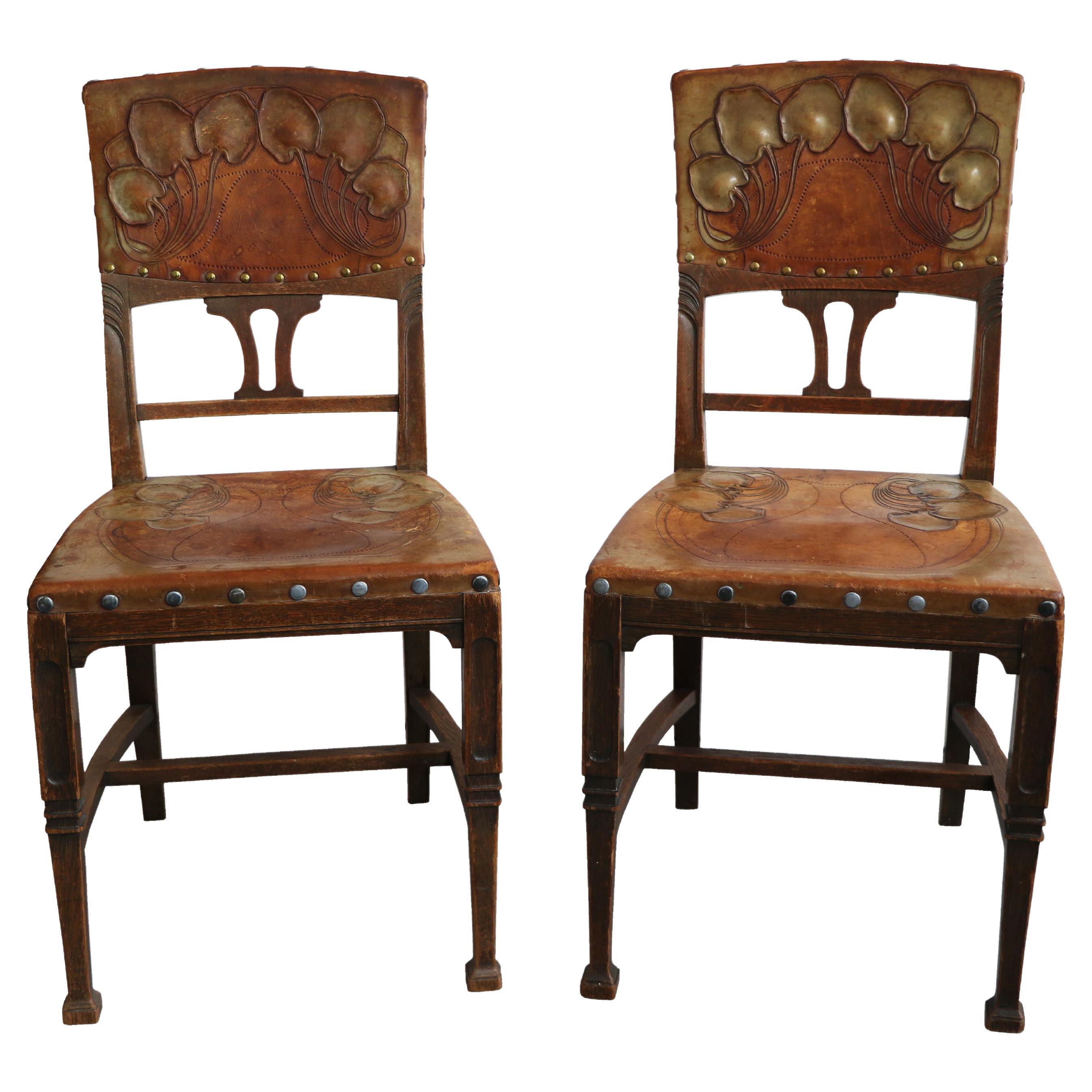Items Similar to Sculptural Chairs Art Nouveau by Giacomo Cometti in Ebonized Hand Carved Walnut
Want more images or videos?
Request additional images or videos from the seller
1 of 10
Sculptural Chairs Art Nouveau by Giacomo Cometti in Ebonized Hand Carved Walnut
About the Item
Pair of sculptural chairs Art Nouveau by Giacomo Cometti in ebonized hand carved walnut in good conditions, with probable original upholstery still usable, sanitized by us.
The two chairs carved the two initials of the author in the center of the back
We Done woodworm treatment as a precaution only and polished with wax
Measures cm: H 87/45, W 44, D 44
About Giacomo Cometti:
italian sculptor, furniture designer and cabinet maker
Giacomo Cometti (October 23, 1863 Turin – January 1, 1938, Turin) was an Italian sculptor, furniture designer, and cabinet maker. due to the early death of his father, Giacomo joined the shop of sculptor odardo Tabacchi and sculptor and cabinet maker Davide Calandra. While he was working in the shop, he was also attending the Albertina Academy of Fine Arts in Turin, from which he graduated in 1881.
After graduation, he became a pupil of Italian symbolist sculptor Leonardo Bistfolti working as an apprentice at his shop. This professional partnership evolved and lasted for over twenty years. At the start of this partnership, Giacomo Cometti collaborated mostly in the execution of bisfolti’s funerary monuments, but besides sculpting Cometti was very active in the field of the decorative and applied arts and in the cabinet-making. At this time Leonardo Bisfolti encouraged him to focus on cabinetmaking, and oriented him to adopt the modernist style.
Giacomo Cometti in particular liked the liberty style. He received the Sculpture Award in the Antwerp Exhibition (1894), a medal for his work as a cabinetmaker for panels designed by Bisfolti in Paris (1900), and an Honorary Diploma at the International Decorative Arts Exhibition in Turin (1902). From this moment on Cometti dedicated himself to the design and execution of furniture and furnishings, which were distinguished by their craftsmanship, their sculptural carvings, and their interlocking ligatures.
In 1903 and 1904, Cometti designed the furniture and windows for the Villa Falcioni, in domodossola, built by architect Annibale Rigotti, and in 1906 he also designed the furniture for the Agosti House in Turin. In 1911 he created the Piedmont Pavilion at the Turin exposition commemorating the fiftieth anniversary of the unification of Italy. His activity intensified after world war i, when his two son angelo, adn his daughter paola, joined him in his practice. In 1923 Cometti received the grand prix of honor at the first biennial of decorative arts in monza, and during the following two years he designed and made the furnishings for the piccolo teatro of casa gualino in collaboration with painter Felice Casorati.
- Creator:Giacomo Cometti (Designer)
- Dimensions:Height: 34.26 in (87 cm)Width: 17.33 in (44 cm)Depth: 17.33 in (44 cm)Seat Height: 17.72 in (45 cm)
- Sold As:Set of 2
- Style:Art Nouveau (Of the Period)
- Materials and Techniques:
- Place of Origin:
- Period:
- Date of Manufacture:1900-1910
- Condition:
- Seller Location:Vigonza, IT
- Reference Number:
About the Seller
4.9
Vetted Seller
These experienced sellers undergo a comprehensive evaluation by our team of in-house experts.
Established in 2017
1stDibs seller since 2017
283 sales on 1stDibs
Typical response time: 6 hours
- ShippingRetrieving quote...Ships From: Vigonza, Italy
- Return PolicyA return for this item may be initiated within 10 days of delivery.
More From This SellerView All
- Pair Original Art Nouveau Chairs, Hand-Carved Blonde Cherry, Leather UpholsteredLocated in Vigonza, PaduaEarly 20th century Italian pair chairs, Art Nouveau , solid hand-carved cherry and leather upholstered. Only strengthened the structure and polished to wax Measure cm: H 108\50, W 4...Category
Early 20th Century Italian Art Nouveau Side Chairs
MaterialsLeather, Cherry
- Art Nouveau Pair of Side Chairs in Walnut, Restored & New UpholsteredLocated in Vigonza, PaduaEarly 20th century Art Nouveau elegant robust couple of side chairs in blond walnut, new upholstered, restored and polished to wax. Measures cm: H 45/100, W 40, D 43.Category
Vintage 1910s Italian Art Nouveau Side Chairs
MaterialsWalnut
- Luois XV Venetian Side Chairs in silvered Hand-Carved Walnut, new upholsteredLocated in Vigonza, PaduaCode: FA41 Elegant Venetian Baroque side chairs in walnut hand-carved and silvered with new blue velvet upholstery.Category
Early 20th Century Italian Louis XV Chairs
MaterialsSilver Leaf
- Art Nouveau 1890s Pair of Lounge Chairs, Hand-Carved Walnut , spring seatLocated in Vigonza, PaduaItalian Art Nouveau 1890s pair of bed room chairs, with hand-carved walnut legs, spring seat, newly upholstered with light dove gray fabric Measures cm: H...Category
Antique Late 19th Century Italian Art Nouveau Lounge Chairs
MaterialsWalnut
- Early 20th Century Art Nouveau Bedroom Chair with Stool in Ebonized WalnutLocated in Vigonza, PaduaEarly 20th century Art Nouveau bedroom chair with stool in ebonized hand-carved walnut restored and polished to wax. Original tapestry fabric in g...Category
Early 20th Century Art Nouveau Bedroom Sets
MaterialsWalnut
- 19th Century Chiavarine Chairs Turned Walnut with Hand-Carved SeatBy Fratelli Levaggi/Guiseppe Gaetano DescalziLocated in Vigonza, PaduaElegant Mid-19th century Chiavarine side chairs in turned walnut and with hand-carved seat, restored and finished to wax Measure cm: H 101\47 x W 45 x D 45.Category
Antique Mid-19th Century Italian Neoclassical Side Chairs
MaterialsWalnut
You May Also Like
- Art Nouveau Side Chair Designed by Thonet, Austria, 1910By ThonetLocated in Antwerp, BEClassic collectible chair by famous German-Austrian cabinetmaker Michael Thonet. Bentwood frame with hooped legs. The seat is embossed with a decorative floral motif.Category
Vintage 1910s Austrian Art Nouveau Side Chairs
MaterialsBentwood
- French Art Nouveau Carved Walnut Side ChairsLocated in Vienna, ATSolid walnut wood construction, upholstered seat. Made in France in 1900-1905. New upholstery on request possible. Delivery time 2-3 weeks. Two pieces available.Category
Antique Early 1900s French Art Nouveau Side Chairs
MaterialsWalnut
- Art Nouveau Set of Six Chairs in Solid Oak. Vienna, c. 1910.Located in Vienna, ATHello, These exceptional set of six Viennese Art Nouveau solid oak chairs from circa 1910 represent a high level of craftsmanship and elegant design. Viennese Art Nouveau is a trend...Category
Early 20th Century Austrian Art Nouveau Chairs
MaterialsLeather, Oak
- Art Nouveau Set of Twelve Chairs in Solid Oak. Vienna, Circa 1910.Located in Vienna, ATHello, These exceptional set of twelve Viennese Art Nouveau solid oak chairs from circa 1910 represent a high level of craftsmanship and elegant design. Viennese Art Nouveau is a trend in Austrian art, architecture and design at the turn of the 20th century. The name was taken from the association formed by a group of artists who protested against the rejection of their work by the Vienna Academy. Gustav Klimt, Otto Wagner, Josef Hoffmann and other artists decided to completely break with the prevailing historicism and promote a new style in art, architecture, and interior design. Art Nouveau focused on simplicity, which foreshadowed modern 20th century design. The elaborate decorations emphasized the close relationship between crafts and Fine arts. Ornamentation (carvings, paintings, marquetry) referred to the world of nature - plants, birds' feathers, insects' wings. Embossed leather with lovely floral elements blends beautifully with the elegant form of the chairs. In the field of ornamentation plant and animal elements were the most important, but not the only set of motifs typical of Art Nouveau in furniture making. They were accompanied by geometric and abstract motifs, and although Art Nouveau is associated with ornamentation, some Art Nouveau furniture is rather simple in form, using shape and line rather than decoration. Compared to other trends of this style, the Vienna Secession was devoid of splendor and rich decoration. It was characterized by sublime simplicity and attention to detail, which paved the way for modern design. Artists creating in the style of Vienna Secession preferred geometric and floral ornaments. Even when using organic motifs, they tended to keep them geometric. Buildings designed in the spirit of the Viennese Art Nouveau often have elegant floral decorations which resemble these beautiful chairs. The set of twelve chairs...Category
Early 20th Century Austrian Art Nouveau Chairs
MaterialsLeather, Oak
- Original Hand Carved and Blackened Reclaimed Oak Sculptural Accent or Side ChairBy Rooms StudioLocated in New York, NYThis hand-carved and blackened reclaimed oak chair, designed by Rooms Studio (from their 2018 Wild Minimalism collection), is inspired by the legacy of traditional Georgian craftsmanship. The Sculptural Chair is meticulously handcrafted of ancient wood, and features a diamond shape cut-out on the top rail, which is curved gently, cradling the back, with a round seat and circular cross stretcher. About the Design Studio: Works of Rooms Studio refers to the sculptural forms and abundant materials in juxtaposition with the feminine instincts. Born and raised in Tbilisi, Georgia, the duo behind the Rooms, Nata Janberidze and Keti Toloraia, lean towards preserving the inherited craftsmanship techniques unique to the region. Massive wood and stone objects are hand-crafted using traditional techniques to create raw and symbolic forms often rooted in the designers' childhood memories. Growing up in a culturally diverse environment, where the two worlds - Western and Eastern collide, remarkably influenced their design language. Over the years, Rooms has created eight independent collections and collaborations equally memorable and representative of the duo's perpetual mission to bring life to omitted elements of a former life. Through their series of works, Janberidze and Toloraia try to examine the boundaries between the public and private. Experiencing adolescent years in the 90s - a significant decade of cultural and societal shifts - their work is a narrative of personal experiences of womanhood. By contrasting the new feminine monumental shapes with architectural brutality, Rooms challenges the status quo and also bridges the conventional and contemporary design with a confluence of female energy. The work of Rooms Studio has concerned itself with questions of nomenclature since the Tbilisi-based design atelier was co-founded by Nata Janberidze and Keti Toloraia in 2007. Take, for instance, the studio’s name: in adopting the basic unit of interior space as the title of their practice, Janberidze and Toloraia also emphasized the emotional force of interiority and inner life in determining their creative output. The studio’s largest U.S. exhibition to date, "Distant Symphony," expands upon this impulse to focus inward. The title is again a chief concern—some of the objects included here were designed during the global pandemic, under a regime of forced isolation that made the studio’s typically collective work process untenable. The pieces shown here are the results of Rooms’ search for a way forward. The first room, an antechamber of sorts, evokes the intimate quality of a private home. Shown here are trinkets and personal effects chosen by Janberidze and Toloraia for their emotive qualities; a low background noise emphasizes the climate of urban domesticity. The ensuing gallery space features highlights of Rooms’ recent design output. Here, the subtle scent of organic materials provides a sensory indication of the atelier’s interest in dichotomies: natural and man-made, personal and collective, local and cosmopolitan. In light of the global circumstances, Janberidze and Toloraia felt it was especially important to pursue collaborative work. Rooms invited three artists—Shotiko Aptsiauri, Salome Chigalashvili and Mariana Chkonia—to conduct a dialogue and shared design process. As such, this exhibition is a kind of polyphonic meditation on a need for solitude and desire for companionship. The practice of polyphonic singing, essential to Georgian folk culture, is reinterpreted here as a design endeavor. Chigilashvili, working with unprocessed yarn, interpreted folk motifs by adapting embroidery to the scale of furniture with expansive stitches applied to painted boards...Category
21st Century and Contemporary Georgian Chairs
MaterialsOak, Reclaimed Wood, Wood
- English Carved Walnut Side ChairLocated in Wilson, NCThis chair is carved on all sides with intricate interlaced grapevines with grape clusters on a stipled background.Category
Antique 1850s English Side Chairs
MaterialsWalnut
Recently Viewed
View AllMore Ways To Browse
Sculptural Chair
Sculptural Chairs
Hand Carved Chair
Antique Hand Carved Chairs
Antique Hand Carved Chair
Hand Carved Antique Chairs
Ebonized Chair
Two Antique Chairs
Antique Chair Art
Sculptural Back Chairs
Pair Sculptural Chairs
Pair Of Sculptural Chairs
Italian Carved Chair
Hand Carved Pairs Of Chairs
Shop For Used Chairs
Antique Hand Made Chair
Sculptural Chair Italy
Sculptural Italian Chair
